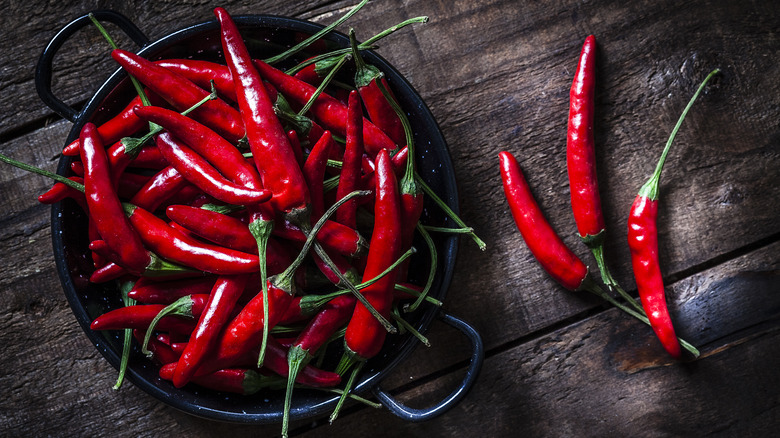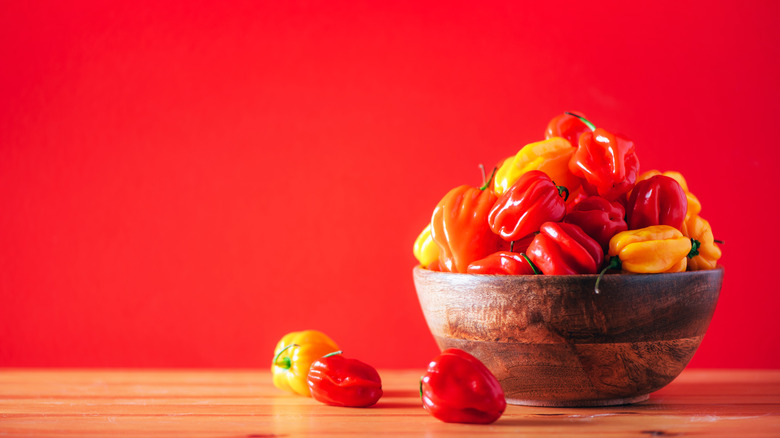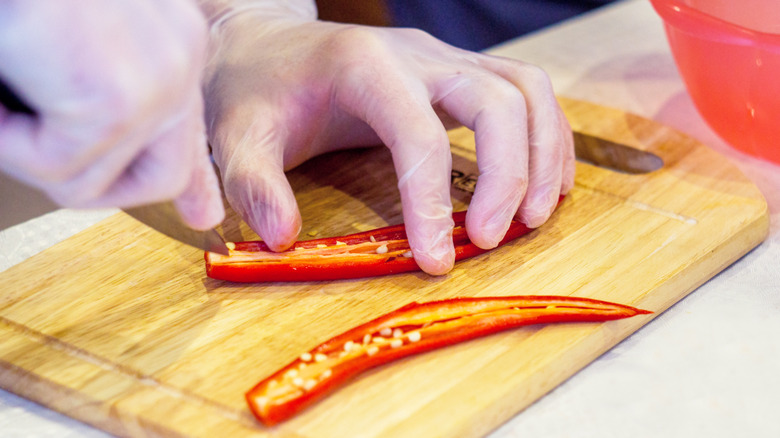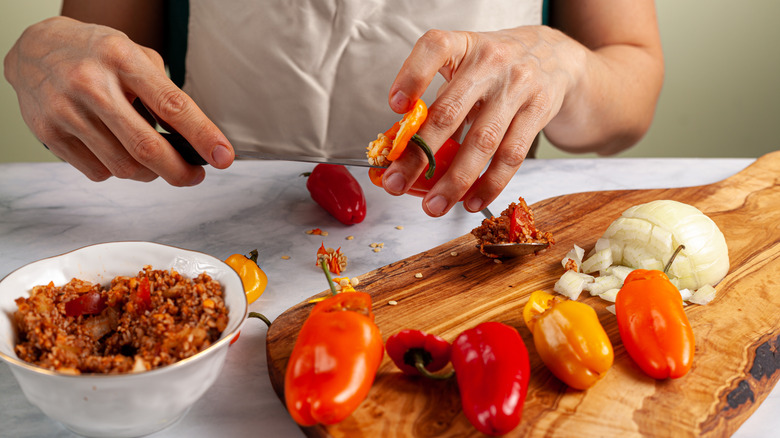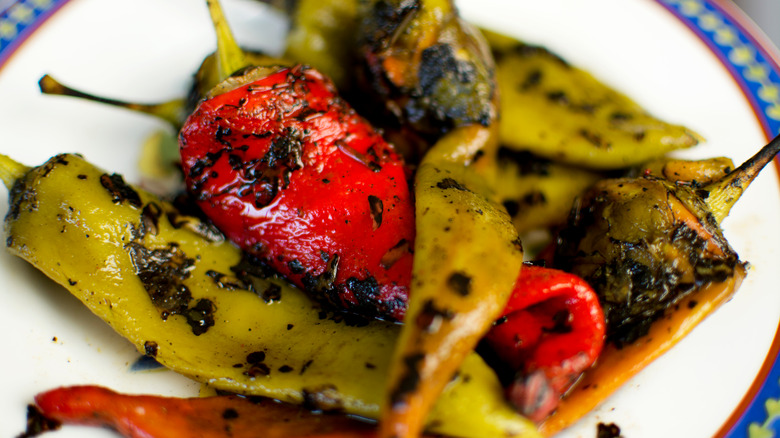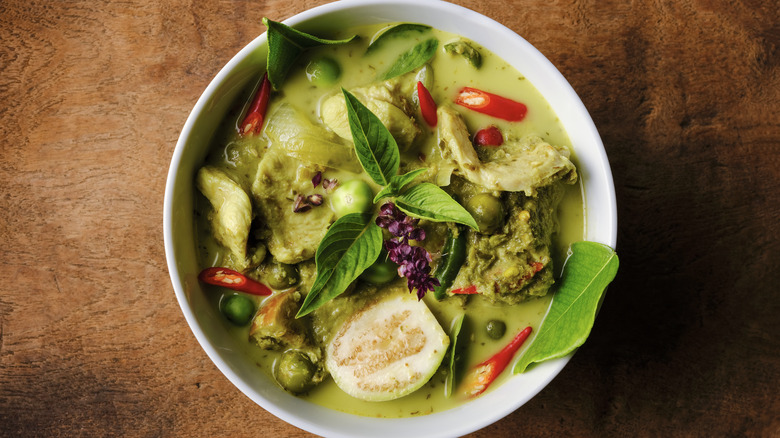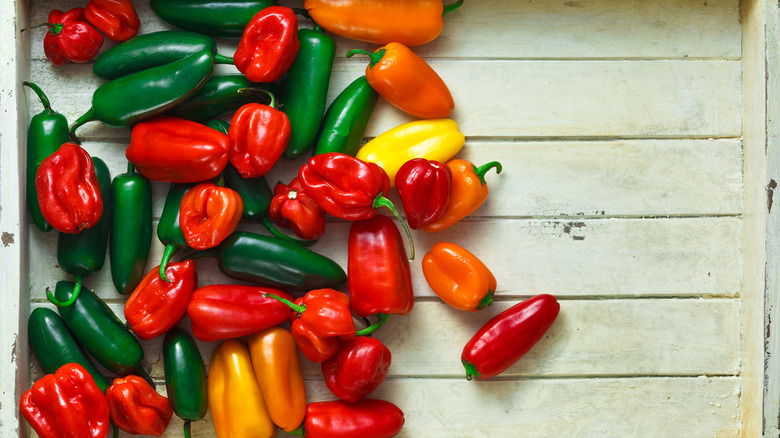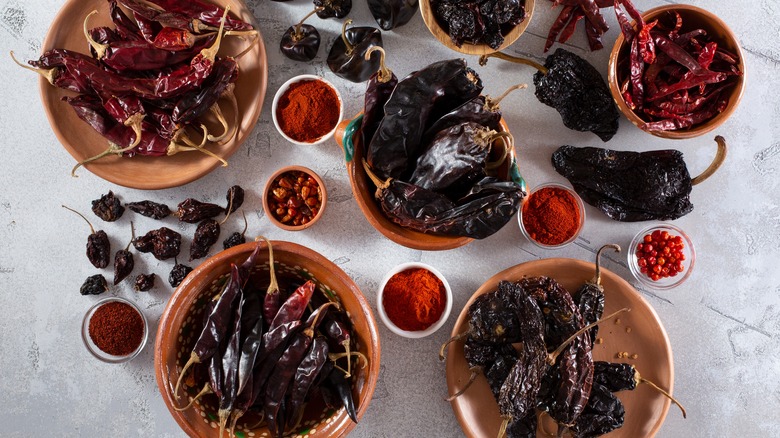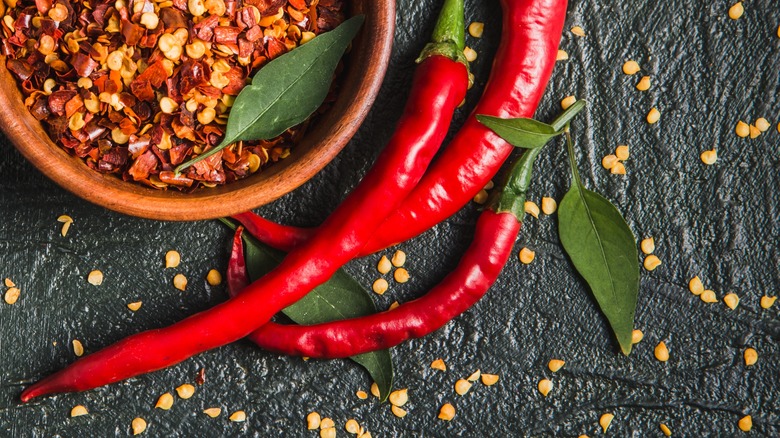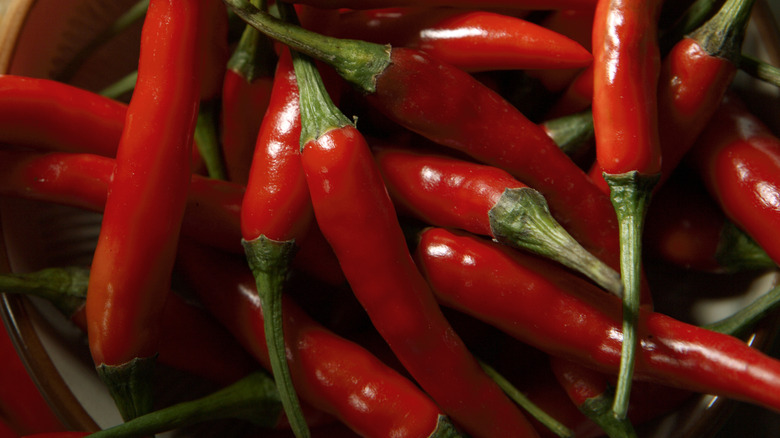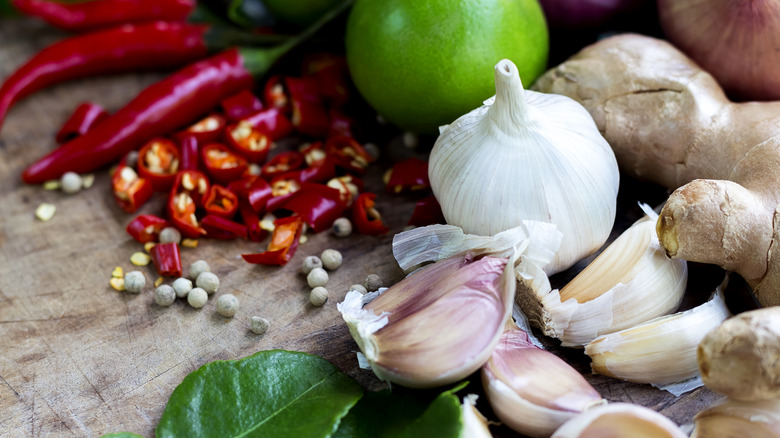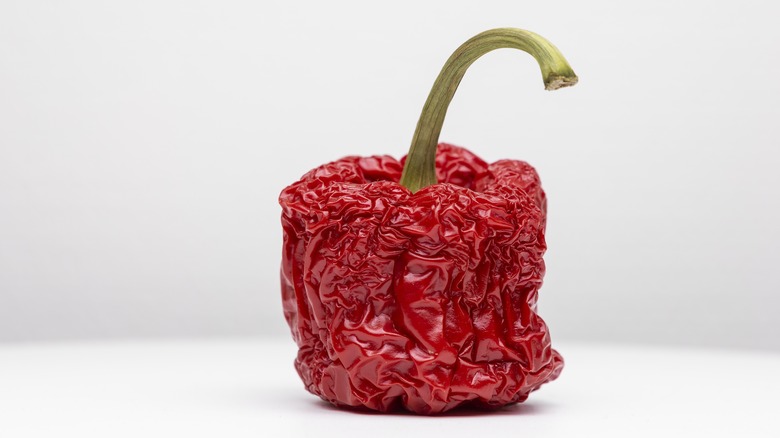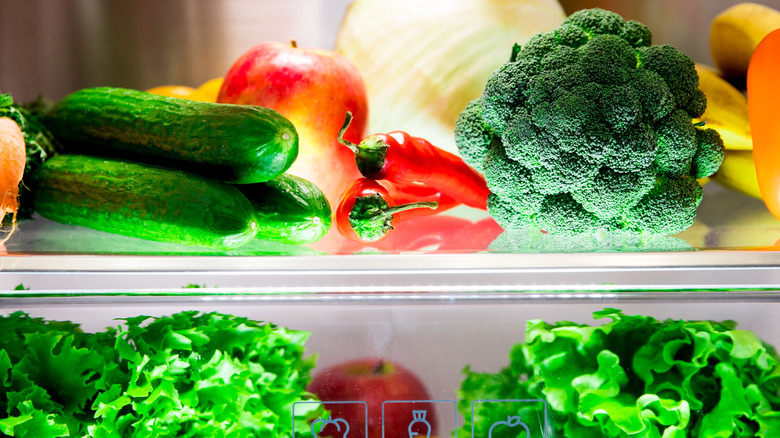12 Mistakes Everyone Makes With Chiles
You might love chiles, but struggle when you come to cook with them. Or perhaps you've never been a huge fan, but you're trying to branch out and increase your spice tolerance. Whatever your relationship with chile peppers, it can be a comfort to know there are a range of mistakes everyone makes with chiles.
These peppers add depth, complexity, and a tantalizing kick to dishes, making them an integral part of many cuisines around the world. However, navigating the world of chiles isn't without its challenges, and even the most seasoned home cooks can find themselves stumbling into common pitfalls.
The allure of chiles lies not only in their heat but also in the flavors they bring to the table. From the fruity undertones of habaneros to the earthy richness of poblanos, each variety offers a unique taste profile waiting to be harnessed. Yet, mastering the art of chiles requires an understanding of their nuances and a keen awareness of the mistakes that can lead to less-than-optimal results.
From not handling chiles correctly and ending up with streaming, burning eyes to failing to balance the heat in the dish with other flavors, leaving it one note, there are all kinds of mistakes you can make. Luckily, you're in the right place to learn about these missteps and how to fix or avoid them.
1. Thinking all chiles are equally spicy
Some people assume that chiles are chiles and they're all roughly equally spicy. This is a mistake in itself but it can lead to two further pitfalls. Either, you might assume that all chiles are too hot for you and give them a wide berth when you needn't, or you may end up severely over-spicing a dish, assuming that a super-hot chile is moderately spicy.
The fact is, not all chiles are equally spicy — their heat level varies widely. The level of spiciness in chiles is measured using the Scoville Heat Scale, which assigns a numerical value to the amount of capsaicin, the compound responsible for the heat, in a particular chile pepper. The higher the Scoville Heat Units (SHU), the spicier the pepper.
There's a huge gulf between some of the hottest and some of the mildest chiles. For instance, the Carolina reaper is one of the hottest chiles in the world, with an average Scoville rating of over 1.6 million SHU. Native to India, the ghost pepper is another extra-hot chile, with a Scoville rating of over 1 million SHU.
On the milder end of the spectrum, we have the Anaheim pepper, which is generally mild, with a Scoville rating ranging from 500 to 2,500 SHU. The poblano pepper is another mild one, usually ranging from 1,000 to 2,000 SHU.
2. Not being careful when handling them
One of the biggest mistakes people make when cooking with chiles is not being suitably careful when handling them. Handling chiles, especially hot varieties, requires some precautions to prevent skin irritation and potential harm. There are some safety precautions you should consider when working with chiles. Be cautious not to touch your face, eyes, or any sensitive areas while chopping or prepping chiles, even if you're wearing gloves. Chiles contain capsaicin, and contact with these areas can lead to discomfort or pain.
After handling chiles, wash your hands thoroughly with soap and water. Be especially diligent with cleaning under your fingernails and between your fingers. If you're worried or if you're working with extremely hot peppers, consider wearing disposable gloves to protect your hands from the oils in chiles. This helps prevent irritation and burning sensations and means you don't have to worry about traces remaining on your hands after washing.
You should also be mindful of surfaces, utensils, and cutting boards that come into contact with chiles. Wash them immediately to prevent the transfer of capsaicin to other foods. Cut, chop, or process them as efficiently as possible to reduce prolonged exposure. This makes handling chiles sound scarier than it is, but you shouldn't underestimate them. It's not fun being left with burning skin or rubbing chile juice into your eyes. Don't stress, but do be cautious.
3. Ignoring the membrane
The membrane of a chile, also referred to as the "placenta," is the white, pithy part inside the pepper that connects the seeds to the flesh. The spiciness of a chile is primarily concentrated in the membrane. While the seeds are often considered the spicy part of the chile, this isn't strictly true. The membrane can transfer some extra heat to the seeds, but it isn't where the heat is stored.
If you want to reduce the spiciness in a dish, removing the membrane and seeds can help achieve that. All you need to do is slice the chile in half lengthwise and use a small, sharp knife to excise the membrane from the rest of the chile.
It's important to note that while removing the membrane and seeds can decrease the spiciness, it won't get rid of it altogether. You'll also be left with all the depth of flavor you want from the chile, which means you can incorporate more chile flavor without an excessive amount of heat.
4. Failing to realize that roasting reduces their heat
Roasting chiles can reduce their heat to some extent. The heat reduction occurs because the roasting process breaks down some of the capsaicin, the compound responsible for the spiciness in chiles. Additionally, roasting can bring out the natural sweetness and smokiness of the chiles, enhancing their flavor profile.
While reducing the heat of your spicy peppers can be good or bad, depending on what you want from your dish, not knowing about the heat reduction is a mistake that can lead to issues. In some recipes, the specific level of heat from raw chiles is essential for achieving the intended flavor profile. Roasting may alter the balance of flavors, and in such cases, using raw chiles may be more appropriate. You might want plenty of heat from chiles in your dish and not realize that you should increase the quantity of them in your recipe to maintain their spice level.
However, there are times when this reduction of heat is a good thing. For instance, you might want to maintain the flavor of a particular type of chile but reduce its heat. In this case, roasting can be a great technique. It allows you to balance the spiciness while enhancing the overall flavor. Roasting imparts a smoky flavor to chiles, which can add depth and complexity to certain dishes. This smokiness is often desired in recipes like salsas, soups, and sauces.
5. Using the wrong chile for the dish
Different varieties of chiles have distinct flavors, ranging from mild and sweet to smoky, fruity, or intensely spicy. The choice of which chile to use in a particular dish depends on the desired flavor profile, heat level, and the cuisine you are preparing. If you aren't paying attention to this, you might be using the wrong chile for the job, giving you subpar results.
For example, the Anaheim pepper has a mild heat with a slightly sweet taste. It's good for roasting, stuffing, and adding a subtle heat to dishes like salsas or sauces. It's often used in Mexican cuisine, so it wouldn't be a good choice for a Thai curry — nor would it be a good choice if you wanted to make an extremely spicy dish.
So, how do you make sure you're using the right chile? First, check the recipe to see if it specifies. If not, think about the overall taste you want to achieve in your dish. Some chiles contribute smokiness, while others bring a fruity or earthy flavor. Also consider the spiciness of the chile and how much heat your dish can tolerate. Adjust the type or quantity of chiles accordingly. Plus, different cuisines use specific chiles traditionally. For example, jalapeños are common in Mexican cuisine, while bird's eye chiles are prevalent in Thai dishes. This can help point you in the right direction.
6. Not knowing the difference between red and green chiles
Some people think that red chiles are red and green chiles are green and that's just the way it is. However, the difference between red and green varieties is their level of ripeness. Understanding this and what it means for their flavor profile will help you to cook with chile peppers like a pro.
The primary difference between red chiles and green chiles is how ripe they are. Both red and green chiles of the same variety come from the same plant. Their color is an indicator of their maturity. That's why you can buy red jalapeños and green jalapeños, for instance.
When they're green, it means they're harvested before reaching full maturity. They are picked while still green, before they have a chance to turn fully red. Green chiles tend to have a milder flavor compared to their mature counterparts, which can be slightly bitter or lacking in complexity.
As chiles ripen, they change color from green to yellow, orange, and eventually red. Red chiles are fully mature and have a different flavor profile than their green counterparts. They are often sweeter with a more nuanced flavor profile. They can also be hotter, as the capsaicin levels may increase during the ripening process.
7. Ignoring dried chiles
Only ever using fresh chiles limits your culinary horizons. Dried chiles are a valuable and versatile ingredient in cooking, and they offer distinct flavors, textures, and uses compared to fresh chiles. Ignoring dried chiles in your cooking means missing out on the depth and complexity they can bring to a wide range of dishes.
Why are dried chiles so great? Well, drying chiles removes the water content, intensifying their flavor. This concentrated flavor can add depth and richness to dishes, enhancing the overall taste profile. They're versatile and can be used in various ways, including rehydrating them for use in stews, sauces, and salsas. They can also be ground into powders or crushed for spice blends, providing a different flavor dimension. They also have a longer shelf life compared to fresh chiles. They can be stored for an extended period without losing their potency, making them a convenient pantry staple.
But that's not all — drying alters the flavor profile of chiles, bringing out unique characteristics. For example, dried ancho chiles have a sweet and smoky flavor, while dried arbol chiles provide intense heat. This variety allows you to choose the dried chile that best complements your recipe. Dried chiles are commonly used in the preparation of sauces, marinades, and spice rubs. They can be blended, toasted, or rehydrated to create flavorful bases for a variety of dishes.
8. Not knowing how to substitute fresh chiles
Sometimes you might not have access to fresh chiles and instead want to substitute them for ingredients such as dried chiles, red pepper flakes, or chili powder. It's important to know how to do this correctly or you might end up with a dish that's way too spicy. However, keep in mind that each type of chile has its own intensity and flavor profile, so the substitution may alter the taste and heat level of your dish.
First, let's talk about using dried chiles as a substitute for fresh ones. This works especially well if you can use the same variety of dried pepper as the fresh one you're substituting. Use 1 ounce of dried chiles for every 4 ounces of fresh chiles a recipe calls for and you should get similar results.
You can also use red pepper flakes, which are flakes of hot chiles. Use roughly 1/4 teaspoon for every chile you're replacing. Chili powder contains a range of spices, as it's designed to season beef or bean chili, so it won't work in every dish, but you can try using it at a quantity of 1/2 teaspoon per chile you're replacing. Around 1 teaspoon of mild-to-medium hot sauce is also a solid sub for one fresh chile.
9. Not being aware of potential heat variations
You might not know that chiles of the same variety can vary in heat. So, you might generally find ancho chiles have a good level of spice for you, then every now and then find one that's way more spicy than usual. So, if you've ever made a dish the same way 20 times and then one day found it intolerably spicy, this might be why.
There are several factors that contribute to this variability. The heat level of a chile is primarily determined by the amount of capsaicin, the compound responsible for spiciness. The environment in which chiles are grown, including factors like soil quality, climate, and sunlight, can affect their heat level. Chiles grown in different regions or under varying conditions may exhibit differences in spiciness. There's also simple genetic variability. Even within the same variety, this can occur. Different plants of the same variety may produce chiles with slightly different heat levels.
Most of the time, this won't be an issue, but if you're concerned, start by using a smaller quantity of chiles in your recipe. You can always add more later, but it's challenging to reduce spiciness once it's too high. Be prepared to adjust the quantity of chiles in your recipe based on taste. If you find the chiles are hotter than expected, you can balance the heat by adding more of the other ingredients in your dish.
10. Making dishes that are spicy but not flavorful
Sure, chiles have their own flavor, but if you rely on them too much, you'll end up making dishes that are spicy and nothing else. Instead, you should create dishes that are flavorful at the same time as being spicy. Creating dishes that are flavorful and well-balanced, rather than excessively spicy without depth, requires careful consideration of the types and quantities of spices and chiles you use.
Focus on achieving a balance between heat and other flavors in your dish. The goal is not to overpower the dish with spiciness but to enhance its overall taste. Incorporate a variety of spices beyond just heat-contributing ones. Include aromatic spices like cumin, coriander, cinnamon, or paprika to add complexity and depth to the flavor profile. You should also build flavors by layering ingredients. Start with a base of aromatics like onions, garlic, and ginger, then add spices and herbs gradually throughout the cooking process.
Combining sweetness with spiciness can also create a well-rounded flavor profile. Consider adding ingredients like honey, maple syrup, or fruits to balance the heat. Plus, acidity can help cut through the heat and enhance the overall flavor of a dish. Consider using ingredients like lime or lemon juice, vinegar, or tomatoes to add brightness. By being mindful of the overall flavor profile and considering the balance of different tastes and textures, you can create dishes that are not only spicy but also rich, flavorful, and well-rounded.
11. Choosing old or overripe chiles
It's all too common for people to choose chiles that are old, overripe, or otherwise past their best. When selecting fresh chiles, it's essential to choose ones that are fresh, firm, and vibrant in color. Look for chiles that have smooth, shiny skin without wrinkles or blemishes. Avoid chiles that are wilted, shriveled, or have soft spots, as these are signs of age or spoilage.
Fresh chiles should feel firm and crisp to the touch. Avoid chiles that feel soft or mushy, as this indicates they are past their prime. You should also check the stem end of the chile. It should be green and fresh-looking, without any signs of drying out or shriveling.
Next, take a whiff of the chile. Fresh chiles should have a bright, vegetal aroma. If they smell musty or off, they may be old or starting to spoil. Some varieties of chiles, such as jalapeños, can become flexible when they are overly ripe. While a slight bend is normal, excessively flexible chiles may be past their prime.
By following these guidelines and using your senses to assess the freshness and quality of fresh chiles, you can ensure that you select the best ones for your recipes. Additionally, buying from reputable sources and inspecting the produce carefully can help you avoid purchasing old or overripe chiles.
12. Storing them incorrectly
Proper storage is crucial to maintaining the freshness and quality of fresh chiles. If you store them wrong, they won't last as long. It's as simple as that. But, how do you store them correctly?
The best way to store fresh chiles in the vegetable crisper drawer of your refrigerator. The cool temperature helps slow down the ripening process and preserves their freshness. In the fridge, they should last two to three weeks. Allow for proper airflow in the crisper drawer. Do not overcrowd the chiles, as good ventilation helps prevent moisture buildup and reduces the risk of mold or decay. Do not wash the chiles before storing them. Moisture can lead to faster deterioration, so it's best to wash them just before use.
However, if you need to store them at room temperature, that's fine, but they might go bad more quickly. Stored at room temperature, you can expect them to last one to two weeks. For best results at room temp, store them in a paper bag, somewhere cool and dark, such as in a pantry or cabinet.
